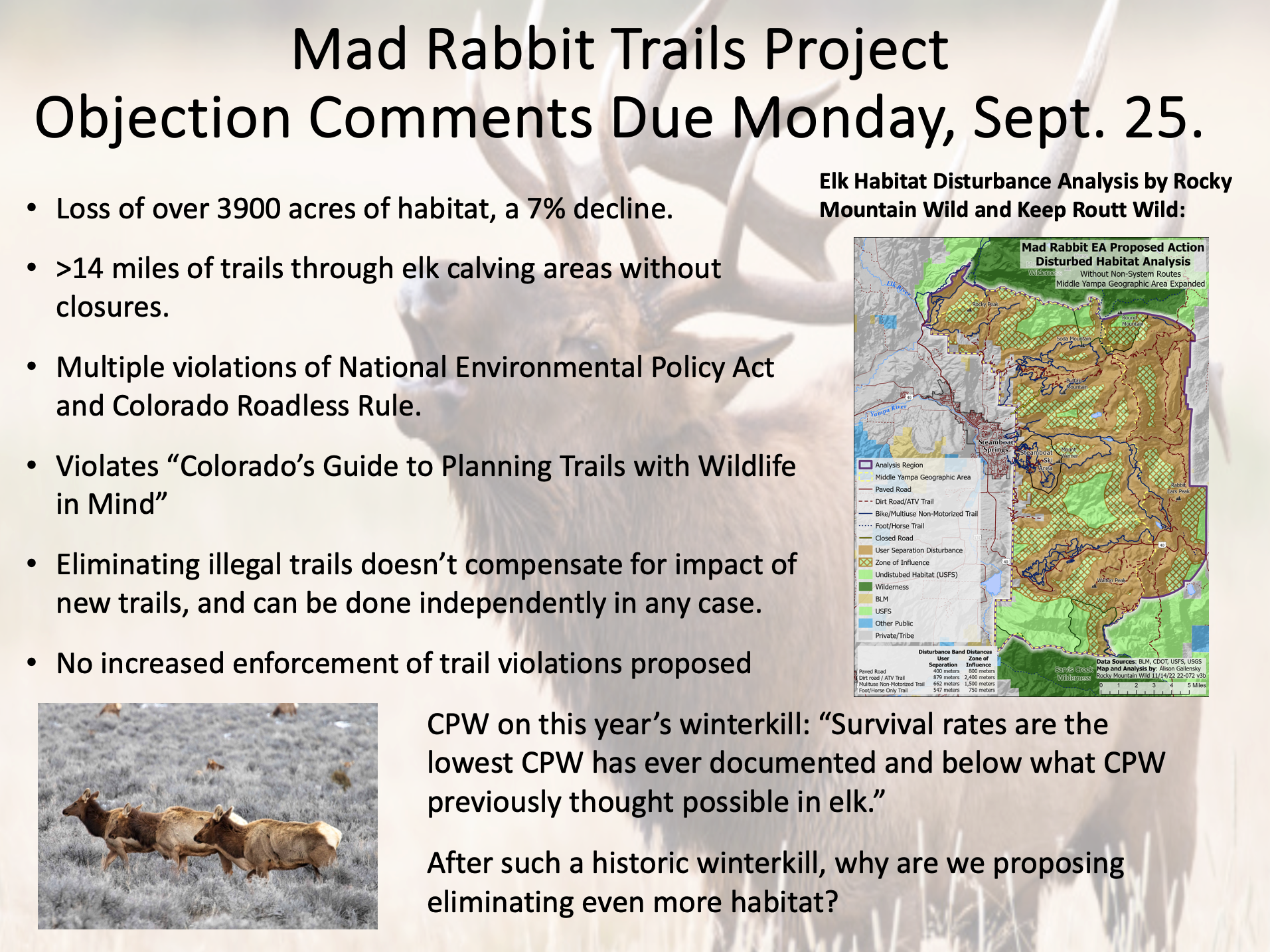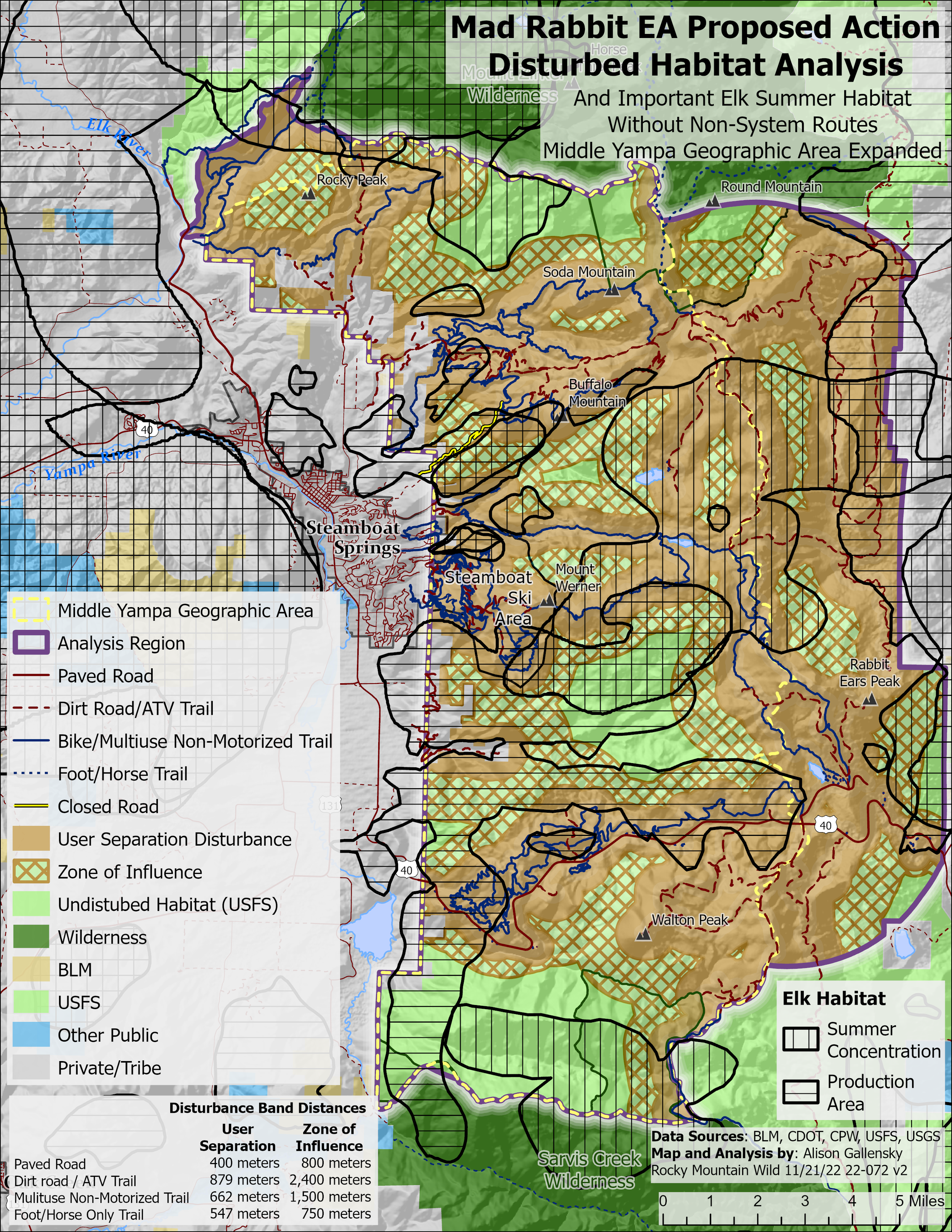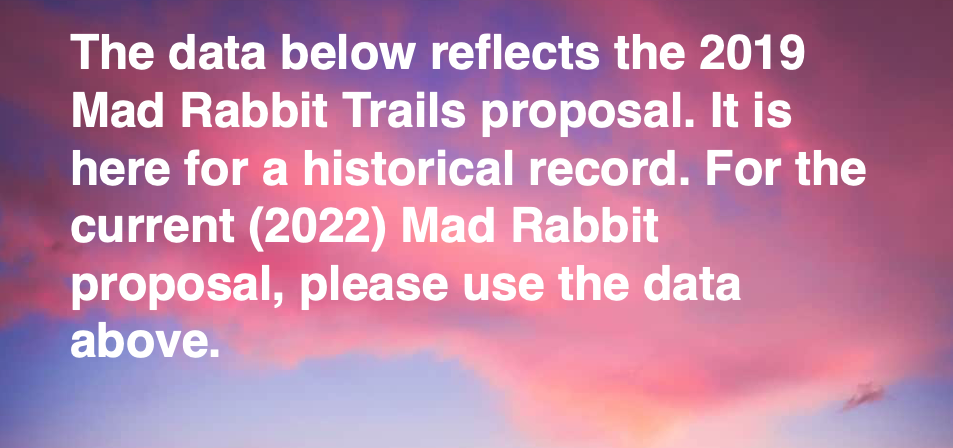News about the Mad Rabbit Trails Project is posted in reverse chronological order, so most recent news is at the top. A summary of where the Mad Rabbit Trails Project currently stands can be found in our January 2024 Newsletter here.
OBJECTION PROCESS
The US Forest Service has released their official response to all objections, and instructions to Responsible Official, District Ranger Michael Woodbridge:
The Forest Service has published the draft Final EA for Mad Rabbit Trails Project in early August. This includes a FONSI (Finding of No Significant Impact). This triggers the Objection period where those who commented previously can object to the decision. Due date is Monday, September 25. (Comments are now closed). We encourage all those who commented on Mad Rabbit in late 2022 to do so again as an objection comment.
Mad Rabbit Trails Project website is here.
Objections can be entered at the link here.
You can review/download the draft Final Environmental Assessment here. (Large file, could take some time to download).
We recommending reading our August 2023 Newsletter to get more insight into the flaws within the Mad Rabbit proposal. The Forest Service is particularly sensitive to objections that raise process errors and errors of fact. Sadly, there are plenty of both. Merely saying you like or dislike the project will be insufficient to change a decision. The objections must be related to an issue you brought up earlier or based on new information.
We believe an effective theme would be to state that the draft Final EA is flawed, and that an EIS (Environmental Impact Statement) is called for. Key points include:
The 1998 Forest Plan that anchors much of the planning for the Mad Rabbit Trails Project is woefully out of date. The National Forest Management Act states that a Forest Plan must be revised every 15 years. A 25 year old plan cannot be used as a substitute for an EIS.
Many of the trails are proposed to be located in Colorado Roadless Areas. The Colorado Roadless rule states, “Proposed actions that would significantly alter the undeveloped character of a Colorado Roadless Area require an Environmental Impact Statement (EIS).” Though brought to the Forest Service’s attention, there is nothing written in the entire EA about this requirement. The massive numbers of tourists this project is planned to attract will clearly alter the undeveloped character of the Long Park Roadless Area.
The Forest Service proposes to close and rehabilitate 36 miles of illegally created trails to attempt to compensate for impacts associated with the new trail building. This is inappropriate for several reasons. First, the Forest Service has allowed unsanctioned trails to persist on forest lands in derogation of its administrative duties. This could have been easily authorized with a Decision Memo. An EA is not needed. Stepping up to do its job now should not be credited as “mitigation” for yet additional impacts of new trails construction. Second, it is arbitrary to make an equivalence between the closing of undocumented trails with rare usage on one hand, and trails proposed for high-volume tourism on the other. This is not backed up by any research included in the EA; human disturbance to wildlife is dependent on the frequency and type of activity, not purely the length of a trail. The Forest Service has not performed any traffic analysis on either the trails proposed to be decommissioned, or on the newly proposed trails. Third, using the removal of illegally created trails as a mitigation allowing for new trails to be built creates perverse incentives for the unauthorized trail builders.
The Forest Service claims that the impacts from Mad Rabbit are minimized because a majority of trails are located within 1 mile of an open road. They claim this is recommended by two research papers, Wisdom 2018 and Wisdom and Johnson 2019. Neither paper discusses the topic. Additionally, even if the papers did recommend such a placement, “open roads” in those papers refers to unpaved Forest Service roads open to the public, not paved roads. Paved roads and even interstate highways have been shown to have a smaller disturbance distance to elk, deer, and other ungulates than recreational trails. The research behind this can be read here.
The Mad Rabbit EA states that the Colorado Guide for Building Trails With Wildlife in Mind is one of the key documents guiding their planning and evaluation. However, they did not come close to following that guide. The Guide has a theme of Avoid, Minimize, and Mitigate. They did not avoid placing trails in elk calving areas, though they could have by placing trails to the south of US40. They did not minimize the impacts of trails that are in those areas. Over 14 miles of trails cross elk calving areas without the recommended seasonal closure from May 15 to June 30. Even those that do have a seasonal closure are contingent on snow levels being 12 inches or less. There is no documentation on how this is derived or measured. This modest snow level does not deter a cow elk seeking a place to give birth. Mitigation is not even proposed, but would consist of a financial transfer to CPW for habitat improvement elsewhere.
There are no maintenance or enforcement plans associated with Mad Rabbit.
The project is part of an overall trails proposal explicitly designed to attract 180,000 incremental summer visitors to the Steamboat area, each staying on average over 4 nights. Prorating for the portion of the project represented by the Mad Rabbit Trails Project adds over 1700 summer visitors per day, impacting local housing and increasing the density of users on the entire trail network. The Forest Service did no planning or estimation of the impacts of this number of visitors.
The Colorado Roadless Rule is clear: “Proposed actions that would significantly alter the undeveloped character of a Colorado Roadless Area require an Environmental Impact Statement (EIS).” Yet, despite the explicitly stated purpose of attracting a huge number of tourists, no EIS is planned.
Additionally, Roadless Areas are designed for primitive or semi-primitive recreation. This is defined as meeting a maximum of 15 other parties over a day. The traffic on these trails will far exceed this metric.The Final EA minimizes the impact to elk. It does not mention that the local E2 Bears Ears elk herd has suffered dramatically this past winter. CPW has stated, “The Severe Winter Zone is an area known for some of the largest elk herds in the nation, and severe winter conditions have resulted in high elk calf and above-average cow mortality. Survival rates are the lowest CPW has ever documented and below what CPW previously thought possible in elk.”
The Forest Service used an obsolete habitat effectiveness model from 1983 to measure elk habitat effectiveness that doesn’t include impact from trails, just roads. They state in the EA, “There is no change in habitat effectiveness from the no action related to the Mad Rabbit proposal. Trails are not part of the calculation for habitat effectiveness.” They used an old model that doesn’t consider impact from trails to evaluate a project consisting nearly completely of trails.
The information below is data from the Draft EA (Environmental Assessment) for Mad Rabbit. Public comments were concluded November 23, 2022. Though there are some minor changes from the Draft EA to the draft Final EA in 2023, the information below is still very relevant to the final proposal.
The US Forest Service is proposing a massive network of trails in Routt National Forest spanning from Mad Creek to Rabbit Ears Pass known as “Mad Rabbit”. Link to the project proposal is here.
Unfortunately, the implementation of the Mad Rabbit Trails Project poses serious threats to wildlife habitat, ongoing conservation efforts in the valley, and will have a harmful impact on other recreational and economic interests in the community. It also sets terrible precedents for roadless areas and tolerating illegal trails. Because of this, 23 organizations have come out opposed to the current proposal.
Keep Routt Wild has engaged the community with respect to Mad Rabbit, proposing a compromise proposal that delivers increased recreation opportunities while protecting wildlife and wildlife habitat. Our proposal relies on the best available science and could serve as a model for balancing recreation and conservation for the entire Rocky Mountain West. We will update this compromise proposal to reflect the new Mad Rabbit proposal.
However, if the final proposal looks similar to this recent proposal, we will fight the project in all available venues. We are working with the community, other conservation groups, and a capable legal team to make sure our land managers follow best practices and the law.
ELK HABITAT ANALYSIS
Keep Routt Wild, in conjunction with Rocky Mountain Wild performed a GIS analysis of recreational disturbance to elk habitat in the proposed Mad Rabbit project area, using Forest Service studies.
Solid brown areas are severely disturbed areas representing habitat loss.
Brown crosshatch areas shows a further Zone of Influence where habitat is compromised.
Horizontal black lines show elk calving areas, while vertical black lines show elk summer concentration areas.
The results show massive disturbance to elk and their habitat.
CLICK IMAGE TO VIEW AS HIGH RESOLUTION IMAGE
What have Routt County locals been saying about Mad Rabbit? Read their letters to the editor here.
19 KEY CONCERNS ABOUT THE PROPOSED MAD RABBIT TRAIL NETWORK
1. The high-volume trails built to attract tourists will have a significant impact on wildlife and habitat, specifically elk habitat.
2. Though branded as “multi-use” trails, these are largely trails designed for high volume mountain biking.
3. The proposed area for Mad Rabbit has already seen deleterious impacts from previous recreation development in the area. The resident elk population of GMU14 has declined from approximately 750 to 500 individuals from 2006 to 2019. Over the same period, the calf/cow ratio has decreased 42% from 0.64 to 0.37 calves/cow elk. This critical metric shows the precarious situation of the local elk herd.
4. The previous development of the Buffalo Pass Trails Project has led to elk abandoning nearby areas, effectively leading to habitat loss for the E2 Bear’s Ear elk herd. This is reflected in the continuing population and recruitment decline of the GMU14 resident elk herd.
5. The proposal specifies the development of new mountain bike trails in elk calving areas and elk summer concentration areas. Scientific peer-reviewed studies have shown trail-based recreation can cause disturbance to elk up to 1500 meters away, leading to habitat loss, compression, and fragmentation.
6. There are 21 miles of proposed Mad Rabbit trails in acknowledged elk calving areas that will have no seasonal closures at all. Peer reviewed research has shown a 5% probability of mortality of an elk calf each time it is disturbed, which can occur as far as 1500 meters away from mountain biking activity. Not placing seasonal restrictions on elk production areas explicitly violates CPW’s “Planning Trails with Wildlife in Mind.”
7. There are no maintenance or trail enforcement plans associated with the funding of the trails. This is essential for protecting wildlife.
8. The majority of the trails will be placed in Colorado Roadless Areas, a designation close to that of a wilderness area. There are numerous violations of the Colorado Roadless Rule presented by this project
9. The project is part of an overall trails proposal explicitly designed to attract 180,000 incremental summer visitors to the Steamboat area, each staying on average over 4 nights. Many of the planned trails are in a Colorado Roadless Area. Prorating for the portion of the project represented by the Mad Rabbit Trails Project adds over 1700 summer visitors per day, impacting local housing and increasing the density of users on the entire trail network. The Colorado Roadless Rule is clear: “Proposed actions that would significantly alter the undeveloped character of a Colorado Roadless Area require an Environmental Impact Statement (EIS).” Yet, despite the explicitly stated purpose of attracting a huge number of tourists, no EIS is planned.
10. The Forest Service only minimally evaluated less impactful alternatives, including placing trails on other already developed public lands or moving the trails outside of calving areas and summer range, or to the south of US 40. All of these alternatives were brought to the US Forest Service’s attention. Not considering these alternatives violates the guidelines regarding alternatives put forth in CPW’s “Planning Trails with Wildlife in Mind.”
11. The dense set of proposed trails near US40 in the area known as Ferndale results in nearly 4 linear miles of trails per square mile of elk habitat, violating the 1 linear mile of trail per square mile of habitat metric specified in CPW’s “Planning Trails with Wildlife in Mind.”
12. The USFS has declined to perform the much needed EIS (Environmental Impact Statement) for a proper cumulative effect analysis for the area, stating it is relying on the 1998 Forest Plan instead. This plan is woefully out of date, and none of the trails included at Buffalo Pass or Mad Rabbit are mentioned in the 1998 plan.
13. Wildlife watching and big game hunting together bring in over $3B of economic activity to Colorado each year. Both activities will be negatively impacted by the proposed trail system. Due in part from previous recreational trails in the area, elk hunting in GMU14 has recently been limited in face of declining population numbers and calf/cow ratio.
14. The Forest Service proposes to close and rehabilitate 36 miles of illegally created trails to attempt to compensate for impacts associated with the new trail building. This is inappropriate for several reasons. First, the Forest Service has allowed unsanctioned trails to persist on forest lands in derogation of its administrative duties. Stepping up to do its job now should not be credited as “mitigation” for yet additional impacts of new trails construction. Second, it is arbitrary to make an equivalence between closing of undocumented trails with rare usage on one hand, and minimization of impacts from trails proposed for high-volume tourism on the other. This is not backed up by any research included in the EA; human disturbance to wildlife is dependent on the frequency and type of activity, not purely the length of a trail. The Forest Service has not performed any traffic analysis on either the trails proposed to be decommissioned, or on the newly proposed trails. Third, using the removal of illegally created trails as a mitigation allowing for new trails to be built creates perverse incentives for the unauthorized trail builders.
15. Due to many of the above issues, community opinion in Steamboat Springs and Routt County has shifted decidedly against this project. A recent survey of Routt County residents showed overwhelming support for a balanced approach to recreation and conservation (>70%), with the least chosen option (recreation is more Important than conservation) gathering only 3% of the respondents.
16. More human pressure on public lands will lead to deer and elk being pushed onto private agricultural lands, causing damage
17. The Steamboat Chamber of Commerce publicizes “"Steamboat is one of America’s premier mountain biking meccas with more than 500 miles of singletrack bike trails that wander through meadows flecked with wildflowers and twist around aspen groves.” With such a large existing local trails network, there is not an urgent need to develop trails in currently undeveloped areas of Routt National Forest.
When is enough enough?
18. We face unbalanced risks with the Mad Rabbit decision. We can always use a different trail, but habitat loss is forever.
19. There is value in wild places. Let’s keep Routt wild.
ADDITIONAL DATA
The Forest Service Mad Rabbit Trails Project proposal is here.
Comment letter from Colorado Wildlife Conservation Project is here.
A second letter from Colorado Wildlife Conservation Project regarding ungulate recover in northwest Colorado is here.
Comment letter from other conservation groups is here.
Comment letter from DNR/CPW is here.
Information regarding earlier proposals for Mad Rabbit.
KEEP ROUTT WILD COMMENTS ON 2019 PROPOSAL BELOW
Since our objections to Mad Rabbit, the US Forest Service has responded with a new proposal. The news release and summary can be found here. The actual proposal can be found here, after expanding the 2019 Scoping list.
This proposal is an improvement over the initial proposals. It has eliminated some problematic trails in the Mad Creek area, and will remove some illegal trails in that area as well. Keep Routt Wild endorses those changes. Nevertheless, many other trails in the 50 miles being proposed will continue have a deleterious effect on wildlife, including habitat fragmentation and impacts on elk calving areas. Keep Routt Wild considers the new proposal as evidence the US Forest Service is working in good faith, and has decided to engage with the Forest Service to create a compromise plan that will offer new recreation opportunities while minimizing the impact to wildlife. If the US Forest Service adopts these suggestions, Keep Routt Wild will drop our objections to Mad Rabbit, and will promote the final plan as a best practice for meeting the needs of recreation and wildlife conservation.
Our complete comments can be downloaded at the link below.
SECOND SET OF COMMENTS
After submitting the above comments, Keep Routt Wild acquired new public information, an analysis of Steamboat Springs trails by IMBA (International Mountain Bicycling Association). Here, IMBA prioritized the most needed trail improvements, and none would be met by Mad Rabbit. This serves as an independent analysis showing that mountain bikers have other options, and better options, than creating new trails in pristine areas of our forest. Indeed, the specific improvements called out by IMBA can’t be met even with a modified Mad Rabbit proposal. We believe that the singular focus on Mad Rabbit to provide all the needs of mountain bikers is not beneficial to the cycling community, and adoption of the IMBA recommendations would provide more benefit for mountain bikers and fewer impacts on Routt County’s wildlife. This new information caused Keep Routt Wild to write a second set of comments, below:













